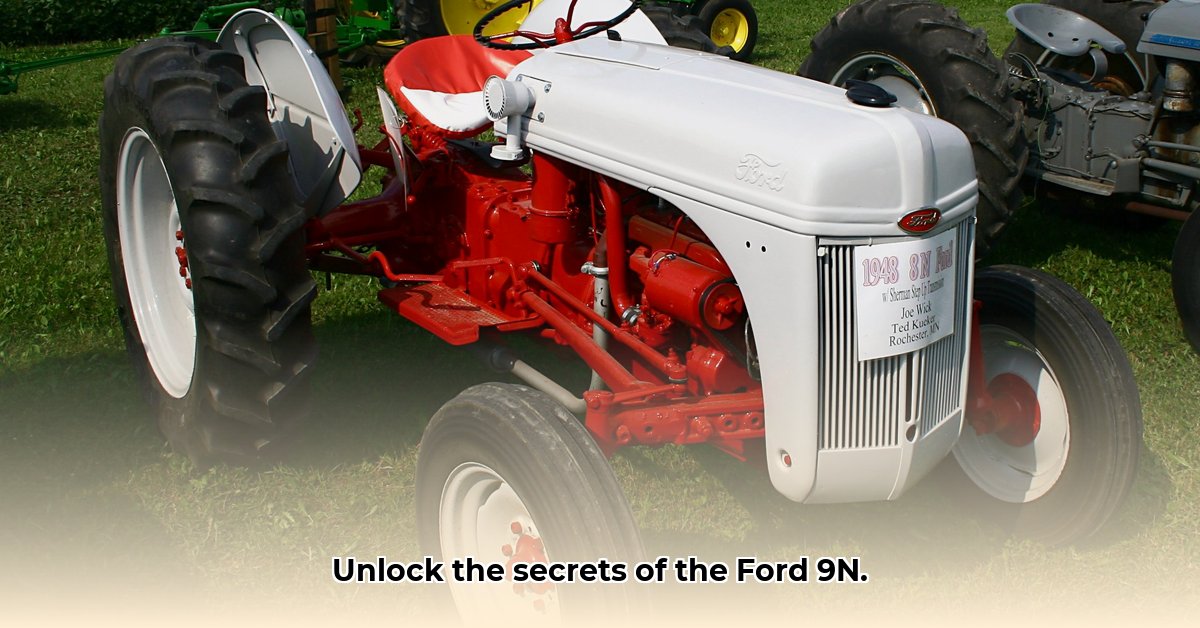
9N Ford Tractor Specs: A Deep Dive into an Agricultural Icon
The Ford 9N tractor: a name synonymous with hardworking farmers and a pivotal era in American agriculture. But beyond the nostalgia, the 9N's story is one of innovative engineering and transformative impact. This guide explores its specifications, clarifies the often-confusing horsepower figures, and delves into its rich history – from the Great Depression to its enduring legacy. For more on Ford tractors, check out Ford Tractor Specs.
Power and Performance: Unraveling the Horsepower Mystery
One immediate challenge in understanding 9N specifications is the variation in horsepower figures reported across different sources. This isn't due to inconsistencies in the tractor itself, but rather in the methods used to measure power during its time. Think of it like measuring a car's speed; a quick acceleration (engine horsepower) differs from sustained hauling (drawbar horsepower). While the 9N's engine produced approximately 26.5 brake horsepower (bhp), the power actually delivered to the wheels (drawbar horsepower) ranged considerably, generally between 16 and 24 horsepower, depending on conditions and the specific measurement technique used. Similarly, belt horsepower, used for powering implements like hay balers, varied, reaching a range of up to 30 depending on measurement methods. This variance, common for tractors of that era, reflects the less standardized measurement practices of the time. Direct comparisons with modern tractors need to account for these methodological differences.
Key 9N Ford Tractor Specifications: A Detailed Overview
The following table summarizes the key specifications of the Ford 9N tractor. Remember that horsepower figures represent ranges, reflecting the technological limitations of the time in measuring power output precisely.
| Specification | Typical Value(s) | Notes |
|---|---|---|
| Engine Type | Four-cylinder, L-head | A reliable, simple design common for its era. |
| Engine Power (approx.) | ~26.5 bhp (engine) | Brake horsepower; the power produced by the engine itself. |
| Drawbar Horsepower | ~16-24 hp (approx.) | Power measured at the drawbar – the force used to pull implements. Varied significantly with conditions. |
| Belt Horsepower (approx.) | ~20-30 hp (approx.) | Power available at the belt pulley for driving equipment. Actual power varied, depending on conditions. |
| Transmission | 3-speed manual | Simple, robust, but offered a limited range of speeds. |
| Weight | Approximately 2140-2900 lbs | Varied slightly according to configuration. |
| Fuel | Primarily gasoline; sometimes distillate fuel | Distillate fuel was an alternative during wartime fuel rationing. |
| Tires (Front/Rear) | Typically 4.00-19 / 8.00-32 | Standard sizes effective for various agricultural uses. |
| Original Price (1939) | $585 | Remarkably affordable, expanding access to mechanization for many farmers. |
The Ferguson System: A Revolution in Agricultural Implements
The 9N's specifications are more than just numbers; they represent a watershed moment in agricultural technology. Its integration of Harry Ferguson's three-point hitch system was revolutionary. This innovative design allowed for vastly simpler attachment and control of implements, dramatically increasing efficiency and ease of use. Before the three-point hitch, attaching equipment was a laborious and time-consuming undertaking. This system's impact was substantial, contributing greatly to the 9N's success and setting a new standard for tractor design.
The 9N's Historical Context: A Product of the Great Depression
The Ford 9N emerged from the challenging economic backdrop of the Great Depression. Its affordability was crucial to its widespread adoption. It offered farmers a pathway to increased productivity at a price point within reach, playing a significant role in boosting agricultural output during a time of great need. While its power may seem modest by today's standards, it represented a remarkable technological advancement during its time.
Enduring Legacy: More Than Just a Tractor
The 9N's influence extended far beyond its production years (1939-1942). Its design heavily impacted subsequent tractor designs, and its core features remain relevant even today. The continued restoration and maintenance of 9N tractors by collectors and enthusiasts are a testament to its enduring historical significance. The Ford 9N wasn't just a machine; it's a symbol of agricultural progress and innovation.
Pivotal Points:
- The Ford 9N's affordability made mechanization accessible to a wider range of farmers during the Great Depression.
- The Ferguson System's three-point hitch revolutionized implement attachment and greatly increased efficiency.
- The 9N's design fundamentally influenced subsequent tractor designs, establishing key features still seen today.